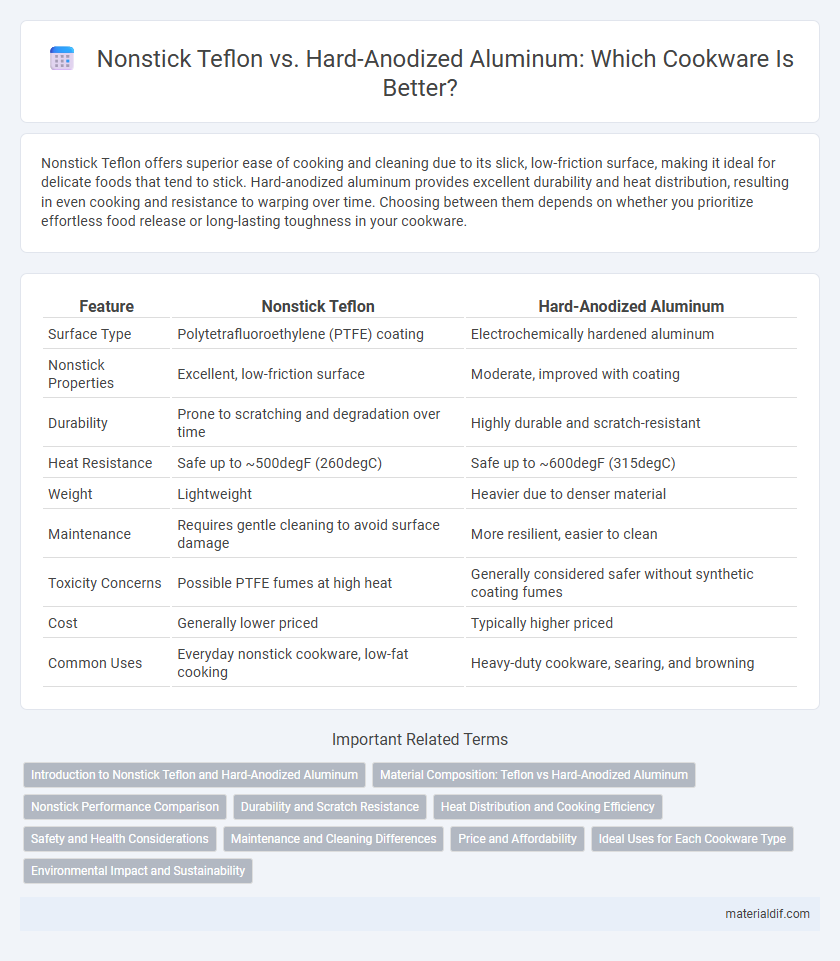Nonstick Teflon offers superior ease of cooking and cleaning due to its slick, low-friction surface, making it ideal for delicate foods that tend to stick. Hard-anodized aluminum provides excellent durability and heat distribution, resulting in even cooking and resistance to warping over time. Choosing between them depends on whether you prioritize effortless food release or long-lasting toughness in your cookware.
Table of Comparison
| Feature | Nonstick Teflon | Hard-Anodized Aluminum |
|---|---|---|
| Surface Type | Polytetrafluoroethylene (PTFE) coating | Electrochemically hardened aluminum |
| Nonstick Properties | Excellent, low-friction surface | Moderate, improved with coating |
| Durability | Prone to scratching and degradation over time | Highly durable and scratch-resistant |
| Heat Resistance | Safe up to ~500degF (260degC) | Safe up to ~600degF (315degC) |
| Weight | Lightweight | Heavier due to denser material |
| Maintenance | Requires gentle cleaning to avoid surface damage | More resilient, easier to clean |
| Toxicity Concerns | Possible PTFE fumes at high heat | Generally considered safer without synthetic coating fumes |
| Cost | Generally lower priced | Typically higher priced |
| Common Uses | Everyday nonstick cookware, low-fat cooking | Heavy-duty cookware, searing, and browning |
Introduction to Nonstick Teflon and Hard-Anodized Aluminum
Nonstick Teflon is a synthetic fluoropolymer coating renowned for its exceptional resistance to food sticking and high-temperature durability, making it ideal for low-fat cooking. Hard-anodized aluminum undergoes an electrochemical process that enhances its surface hardness and corrosion resistance, providing a durable and scratch-resistant cookware base. Both materials offer superior cooking performance, but Nonstick Teflon emphasizes ease of cleaning and nonstick properties, while hard-anodized aluminum focuses on structural strength and heat conduction.
Material Composition: Teflon vs Hard-Anodized Aluminum
Nonstick Teflon coatings consist of polytetrafluoroethylene (PTFE), a synthetic fluoropolymer known for its exceptional nonstick properties and chemical resistance. Hard-anodized aluminum is aluminum treated through an electrochemical process that creates a thick, hard oxide layer, enhancing durability and corrosion resistance without adding a nonstick surface on its own. The primary difference in material composition lies in Teflon's polymer-based coating providing low surface energy for stick resistance, whereas hard-anodized aluminum relies on a dense metal oxide layer offering strength and heat distribution.
Nonstick Performance Comparison
Nonstick Teflon coatings provide superior release properties, allowing food to glide effortlessly and reducing the need for excess oils or fats. Hard-anodized aluminum offers durability and even heat distribution but generally requires seasoning or additional nonstick layers to match Teflon's slick surface. In terms of nonstick performance, Teflon excels with low friction and easy cleaning, making it ideal for delicate foods and everyday cooking tasks.
Durability and Scratch Resistance
Nonstick Teflon coatings offer excellent initial nonstick performance but can degrade over time due to scraping, showing lower durability compared to hard-anodized aluminum. Hard-anodized aluminum surfaces provide enhanced scratch resistance and structural strength by undergoing an electrochemical process that creates a dense, hard layer resistant to abrasion. This makes hard-anodized aluminum cookware a more long-lasting option under heavy use, maintaining surface integrity better than traditional Teflon coatings.
Heat Distribution and Cooking Efficiency
Nonstick Teflon coatings provide excellent heat distribution by allowing even cooking temperatures across the surface, reducing hotspots and ensuring food cooks uniformly. Hard-anodized aluminum offers superior heat conductivity and durability, promoting efficient heat transfer and faster cooking times due to its dense, oxidation-hardened layer. Combining Teflon's nonstick properties with hard-anodized aluminum's heat efficiency creates ideal cookware for both ease of use and optimal cooking performance.
Safety and Health Considerations
Nonstick Teflon cookware is prized for its easy food release and minimal oil use, but concerns arise when overheated above 500degF, potentially releasing toxic fumes harmful to birds and humans. Hard-anodized aluminum offers a nonreactive, durable surface that withstands high temperatures without chemical breakdown, reducing health risks associated with cookware coatings. Choosing hard-anodized aluminum can provide a safer cooking experience by avoiding the degradation issues linked to traditional nonstick Teflon surfaces.
Maintenance and Cleaning Differences
Nonstick Teflon cookware requires gentle cleaning with nonabrasive sponges and mild detergents to preserve its coating and prevent peeling, while hard-anodized aluminum offers greater resistance to scratches and can withstand more rigorous scrubbing. Hard-anodized aluminum surfaces often allow for dishwasher use, whereas Teflon-coated pans typically recommend hand washing to maintain their nonstick properties. Proper maintenance of both materials extends their durability, with Teflon necessitating more careful handling to avoid damage to its fluoropolymer layer.
Price and Affordability
Nonstick Teflon cookware generally offers a more affordable price point compared to hard-anodized aluminum, making it accessible for budget-conscious buyers. The manufacturing process for Teflon-coated pans is less costly, resulting in lower retail prices while still providing effective nonstick performance. Hard-anodized aluminum tends to be pricier due to its durable construction and enhanced heat distribution features.
Ideal Uses for Each Cookware Type
Nonstick Teflon cookware excels in cooking delicate foods like eggs and pancakes due to its superior release properties and easy cleanup. Hard-anodized aluminum offers excellent durability and heat distribution, making it ideal for searing, browning, and high-heat cooking methods. Choosing between them depends on whether nonstick convenience or robust performance for intensive cooking is the priority.
Environmental Impact and Sustainability
Nonstick Teflon coatings often contain polytetrafluoroethylene (PTFE), which can release toxic fumes when overheated, raising environmental and health concerns. Hard-anodized aluminum offers increased durability and energy efficiency, reducing the need for frequent replacement and minimizing resource consumption. Sustainable cookware choices favor materials with lower emissions and longer lifespans, positioning hard-anodized aluminum as a more eco-friendly option compared to conventional nonstick Teflon.
Nonstick Teflon vs Hard-Anodized Aluminum Infographic

 materialdif.com
materialdif.com